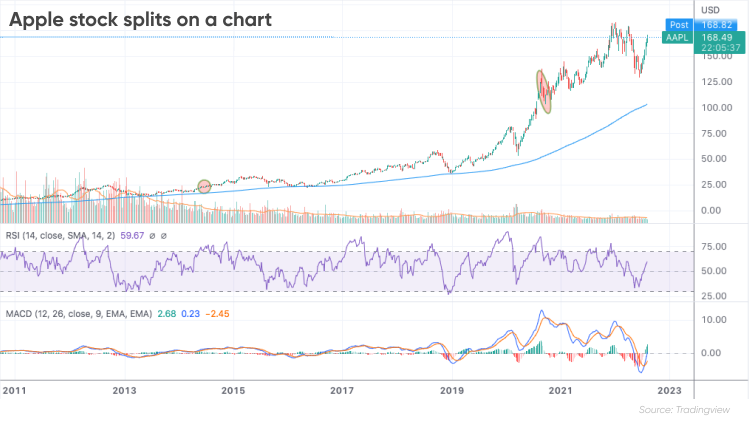
Apple Stock Splitand: What It Means for Investors and the Future of AAPL
Introduction
When it comes to powerhouse companies in the stock market, Apple Inc. (AAPL) often leads the charge with innovation, influence, and strong investor appeal. One of the most discussed financial events involving Apple is the Apple stock split—a topic that continues to generate buzz among both seasoned investors and curious beginners.
Stock splits are not a new concept, but when a major company like Apple announces one, it commands global attention. In this article, we’ll break down what an Apple stock split means, why it matters, how it affects investors, and what the implications are for Apple’s financial future.
What Is an Apple Stock Split?
The term “Apple stock split” refers to Apple’s history and strategic implementation of stock splits—and the combined impact these moves have on stock performance, investor behavior, and market accessibility.
A stock split occurs when a company issues more shares to its existing shareholders. This does not change the overall market capitalization of the company, but it does reduce the price of individual shares while increasing the number of shares available. Apple has gone through several stock splits since it went public in 1980.
The most recent split occurred on August 31, 2020, when Apple executed a 4-for-1 stock split. For every share an investor owned, they received three additional shares, and the stock price was adjusted accordingly. This move lowered the price per share from around $500 to about $125, making the stock more accessible to smaller investors.
Why Apple Chooses to Split Its Stock
Apple’s decisions to split its stock are strategic and beneficial to its long-term brand and market positioning. Here’s why Apple has opted for stock splits in the past:
1. Accessibility for Retail Investors
High stock prices can deter smaller or new investors. By splitting the stock, Apple makes its shares more affordable, expanding its potential investor base.
2. Improved Liquidity
More shares in the market typically mean better liquidity. It becomes easier for investors to buy and sell, which can reduce volatility.
3. Market Psychology
Lower share prices often appear more appealing psychologically. Investors might feel more inclined to invest when a stock appears “cheaper,” even if the company’s value hasn’t changed.
4. Confidence in Growth
A stock split signals that a company has confidence in its continued performance. Apple’s consistent upward trajectory supports these strategic moves.
Historical Apple Stock Splits
Apple has split its stock five times:
| Date | Split Ratio | Price Adjusted |
|---|---|---|
| June 16, 1987 | 2-for-1 | Yes |
| June 21, 2000 | 2-for-1 | Yes |
| February 28, 2005 | 2-for-1 | Yes |
| June 9, 2014 | 7-for-1 | Yes |
| August 31, 2020 | 4-for-1 | Yes |
Each of these splits has marked a milestone in Apple’s journey. After every split, Apple’s stock has demonstrated strong resilience and growth, reaffirming investor confidence.
How Does an Apple Stock Split Affect Investors?
The Apple stock split dynamic directly impacts investors in several ways:
1. Share Quantity Increases
If you own 10 shares during a 4-for-1 stock split, you now hold 40 shares. Your total investment value remains the same initially, but your number of shares grows.
2. Per-Share Price Decreases
Stock splits adjust the stock price. If the price was $500 before a 4-for-1 split, it becomes $125 after the split.
3. No Change in Company Value
Your investment’s total value doesn’t change immediately. Stock splits don’t increase Apple’s intrinsic value—just its share distribution.
4. Better Entry Point for New Investors
A lower share price attracts new investors who may not have been able to afford the stock before.
The Market Response to Apple Stock Splits
Apple stock splits often trigger positive market reactions:
-
Price Appreciation: Historically, Apple’s stock tends to rise in the weeks or months following a split.
-
Increased Trading Volume: More shares and lower prices typically increase trading activity.
-
Media Coverage & Buzz: The announcement and execution of stock splits drive extensive media coverage, contributing to broader public interest.
For example, after the 2020 split, Apple saw a surge in retail investor interest. Platforms like Robinhood reported increased purchases from first-time investors who felt the stock was more affordable.
The Role of Apple Stock Split in Long-Term Investment Strategy
Investors who view Apple as a long-term investment often regard stock splits as an opportunity. Here’s why:
– Stronger Portfolio Positioning
More shares at lower prices can be beneficial for dollar-cost averaging strategies.
– Better Dividend Management
If Apple continues to pay dividends, stock splits can lead to more dividend checks, albeit smaller amounts per share.
– Easier Rebalancing
It’s easier to rebalance your portfolio with lower-priced shares, especially in fractional investing environments.
Potential Future Splits: Will There Be Another Apple Stock Split?
Given Apple’s performance and stock price behavior, investors regularly speculate about the next Apple stock split moment. While there has been no official announcement, the rising stock price (which is again approaching pre-split highs) has sparked discussions of a potential future split.
Analysts suggest that if Apple’s share price moves significantly beyond $200, a split might be on the horizon again to keep the stock appealing to a broader audience.
Frequently Asked Questions (FAQs)
Q1: What is an Apple stock split?
A: It refers to Apple’s historical and potential future stock splits, where the company issues more shares to reduce per-share price, making it more accessible to investors.
Q2: Does a stock split increase Apple’s value?
A: No. A stock split doesn’t change the company’s total market value. It redistributes existing equity into more shares.
Q3: When was Apple’s most recent stock split?
A: Apple last split its stock on August 31, 2020, with a 4-for-1 ratio.
Q4: How does an Apple stock split affect my existing shares?
A: You receive additional shares proportional to the split. For example, if you own 10 shares in a 4-for-1 split, you get 40 shares in total.
Q5: Is a lower share price after a split a discount?
A: No. The price per share decreases, but your overall investment remains the same.
Q6: Should I buy Apple stock before or after a split?
A: Timing a stock purchase should depend on your investment strategy, not just the split. Historically, Apple has performed well after splits.
Conclusion
The concept of an Apple stock split encapsulates more than just a numerical adjustment. It’s a signal of strength, accessibility, and continued market relevance. Apple’s strategic use of stock splits has helped it stay investor-friendly while growing its influence and financial might.
Whether you’re a seasoned investor or new to the game, understanding the impact of Apple stock splits on your portfolio is key. While stock splits don’t magically increase your wealth, they do open new opportunities for participation in one of the world’s most iconic tech companies.
As Apple’s stock continues to rise, investors should keep a close eye on news that could hint at the next Apple stock split—because if history is any indication, it could be yet another stepping stone toward long-term growth.




